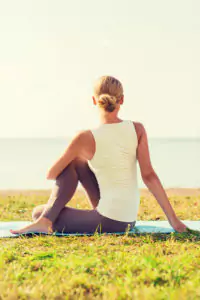Everyone wants a nice looking backside, right. But, those gluteal muscles do a whole lot more than just compliment our favorite jeans.
The buttock, or gluteal muscles are one of the most powerful groups of muscles in the human body. They are actually made up of three muscles – the gluteus maximus, gluteus medius, and gluteus minimus.
Together they contribute to many of the activities our body performs every day. Unfortunately, most of us sit on them and forget about them.
They work as a team with other “core muscles” including the abdominals, low back, and hip muscles. But when most people think of working their core it’s on their back doing crunches, NOT activating the glutes at all.
The result is buttock muscles that are out of balance. This occurs when the glutes are weak or the other muscles are disproportionately over developed. The outcome . . . a negative effect on fitness performance and posture. This, in turn, can lead to long term problems with pain or injury.
In addition, weak glutes are linked to knee, foot, and back pain. You see, when working properly they propel you forward (in running or walker) without putting extra strain on the knees, feet, legs, and low back.
Strong glutes allow you to move more efficiently and pain free. When these muscles are in balance, they adequately support the other core muscles. This is especially important for proper function and movement mechanics in the hips.
The result of strong glutes – improved strength, mobility, stability, posture, and athletic performance. But again, we sit on them all day.
What should we be doing instead?
We need to move and stand throughout the day, as well as spend time in our exercise regimen to strengthen these muscles.
The best place to start is a dynamic warm up of leg swings, lateral side stepping, and bridges. Then get to work with the following glute targeting exercises:
- Deadlifts
- Kettlebell swings
- Stair climbing
- Lunges
- Lateral lunges
- Squats
You will find that during these exercises you will also be activating the other “core muscles” we talked about. Hold your stomach in and keep your back straight . . . It will be a better abdominal workout than you get from planking.
Be sure to add resistance bands or weights as you progress. You must continue to challenge yourself and to continue to see progress.
However, you may find these too challenging or result in pain symptoms if a muscle imbalance is present. Or, you may have no idea how to correctly implement these exercises safely. Either way, one of our physical therapists would be happy to give you some guidance.
Request a call by clicking HERE and get this sorted out right away. We don’t want poor posture, aches, or pains to set in. We want you to BE active and STAY active without any “timeouts” from your daily walks, chasing grandkids, or your running routine.
Keep your backside strong, and fitting in your favorite jeans will be a welcome consequence!


